This site is best
viewed at 800x600
and 16 bit color.
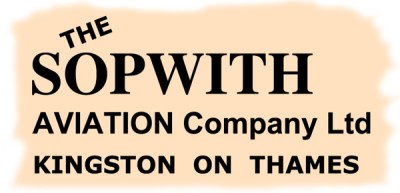 |
|
| Of the many famous aircraft manufacturers in the period 1914-1918, one of the most recognizable names would have to be that bearing Thomas Octave Murdoch Sopwith's name. The Sopwith Aviation Company Ltd of Kingston-on-Thames was formed in 1912 and produced many outstanding designs prior to its demise in 1920, some of which are illustrated here. | |
Sopwith Schneider A development of the pre-war Tabloid, the Schneider entered RNAS use in February 1915. | |
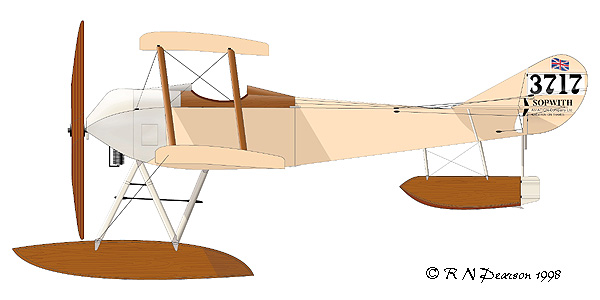 | |
| Sopwith Schneider 3717 FSL J. M. d'A Levy Felixstowe NAS August 1915 3717 was delivered to Felixstowe on 22 July 1915 and was flown by FSL J M Levy on anti-Zeppelin patrol. On 12 August 1915, Levy was shot down by AA after attacking Zeebrugge harbor and taken POW. 3717 was sunk and later salvaged by the Germans, ultimately being placed on display. The only national markings carried by 3717 were the small Union Jacks on the rudder. | |
Sopwith Baby The next progression in the floatplane evolution was the Baby. This was basically a Schneider fitted with a Clerget (110 or 130hp) in a new horseshoe shaped cowl. | |
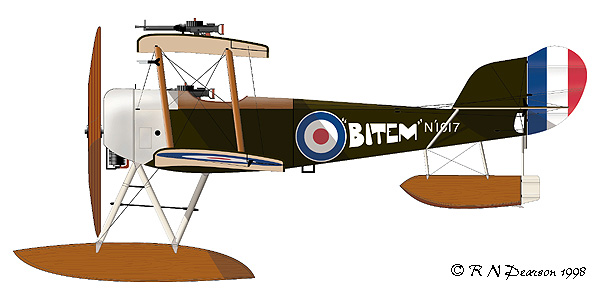 | |
| Sopwith Baby N1017 Dunkerque NAS Summer 1917 N1017 arrived at the Dunkerque NAS on 31 May 1917 where it was given the name 'BITEM'. Note the Lewis machine gun alongside the cockpit fixed to fire through the propellor, plus the second one on the top wing to fire above the propellor arc. | |
Sopwith 1 1/2 Strutter The first Sopwith design to see widespread service was the Land Clerget Tractor - better known as the 1 1/2 Srutter due to the arrangement of its cabane struts. The Strutter was produced in two variants: a single-seat bomber was used by the RNAS Wings as well as license-produced in France (in fact the French built more Strutters than the British); and a two-seat fighter which was used by both the RNAS and the RFC. | |
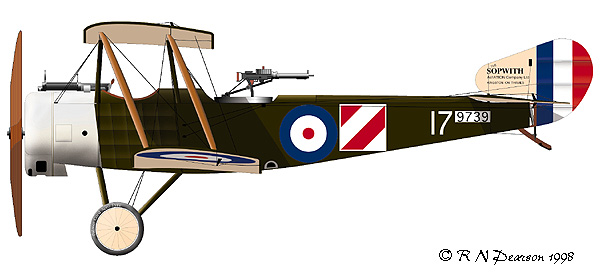 | |
| Sopwith 1 1/2 Strutter 9739 No. 3 Wing RNAS Luxeuil-les-Bains Aerodrome October 1916 A presentation aircraft named 'Britons in Egypt No. 2', 9739 went to No. 3 Wing RNAS, Manston on 28 August 1916, and arrived at Luxeuil-les-Bains on 22 September. On 25 February 1917, FSL L. E. Smith and AM R. S. Portsmouth were shot down by Off.Stv. Gottlieb Vothknecht of Jasta 24 for his first victory. Portsmouth was killed, while Smith was taken POW and later died of his wounds. | |
Sopwith Pup "Good heavens, your aircraft has had a Pup!!" With these words a legend was born. The Sopwith Pup indeed appears to have been whelped from the 1 1/2 Strutter. Maneuverable and able to hold its height in a turn, the Sopwith Pup went on to become a firm favorite of both the RFC and the RNAS. The only drawback was its single gun. At a time that the German Albatros was mounting two Spandau machine guns the Pup only carried a single Vickers. | |
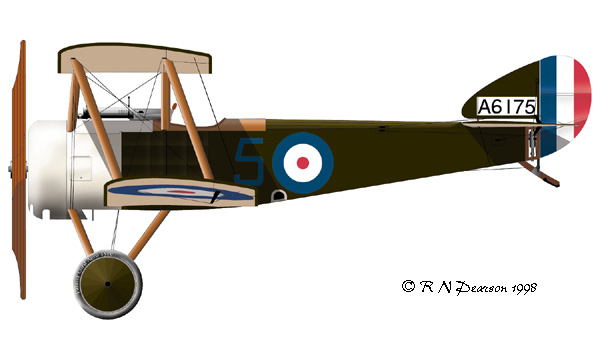 | |
| Sopwith Pup A6175 Lt. R. S. Capon B Flight No. 66 Sqn RFC April 1917 On 24 April 1917, six Pups of No. 66 Sqn RFC were flying escort for nine Strutters of No. 70 Sqn when they were attacked by enemy aircraft. Lt. R. S. Capon in A6175 was shot down by Oblt Lorenz of Jasta 33 and taken POW. Capon had been the first combat loss for No. 66 Sqn. | |
